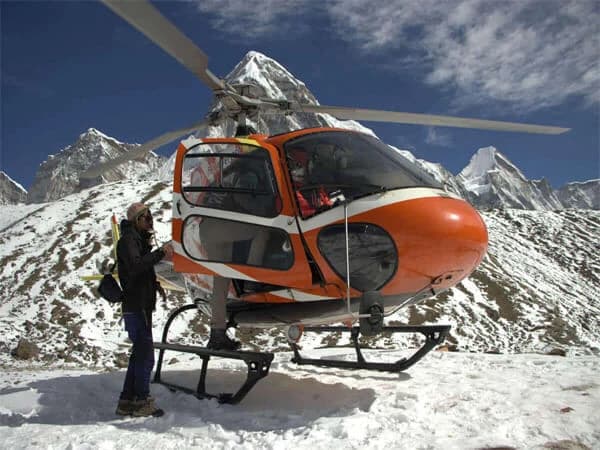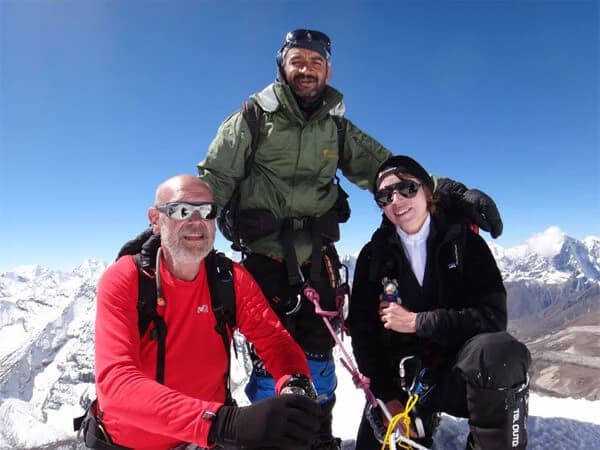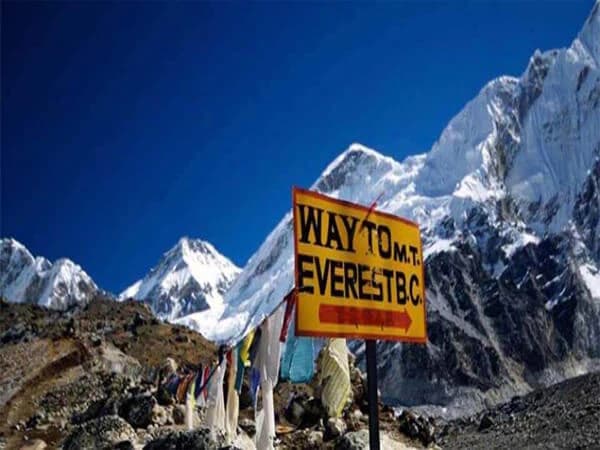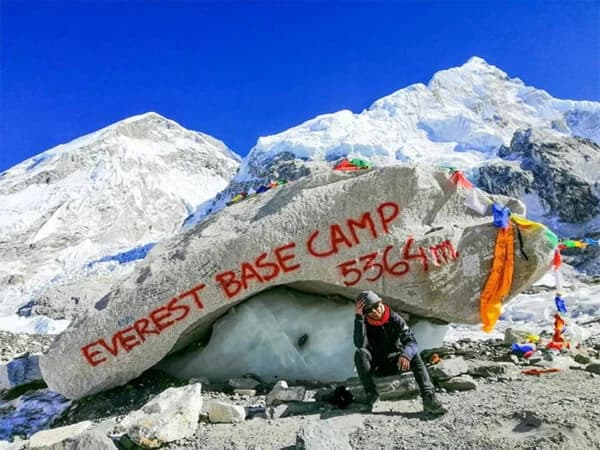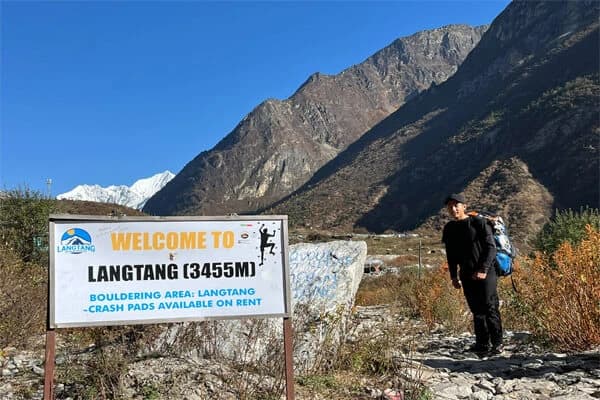The Complete Guide for Everest Base Camp Trek, Nepal is the only one country housing 8 out of the 14 eight-thousanders found in the world. There are around 1,310 mountains above 6,000 meters including the highest peak, Mt. Everest (8,848m). The geography of Nepal extends from the lowland terai to highland Great Himalayas presenting all major climatic zones. There are around 6,000 freshwater rivers and rivulets flowing from the Himalayas to plain land of Terai region. It also has many natural conservation areas protecting a large variety of flora and fauna. Moreover, one can find more than 125 ethnic communities speaking nearly 129 different languages. Therefore, although a small Himalayan country located in South Asian Region, it is the Number 1 Tourist Destination in the world.
Every year, millions of international tourists come to Nepal for doing tours and treks to experience the natural and cultural wonders of it. The Himalayan regions serve as the best trekking regions for the travelers who want to delve into wilderness quite away from the hustling and bustling city life. Trekking in Nepal gives you a chance to get a lifelong memory of the spellbinding vistas of snowcapped peaks, high altitude villages and amazing landscapes. The biodiversity of the tropical forests to alpine region (Sagarmatha National Park) are the calling factors to the foreign people. The endangered animals like one-horned rhino and the Royal Bengal Tiger found in the terai as well as musk deer and snow leopards found the Himalayan conservation areas are equally important assets of Nepalese tourism industry.
Dream to see Head of The Earth Mt Everest Base Camp
Similarly, 10 UNESCO World Heritage Sites and 15 cultural sites enlisted in the Tentative List are the determinants of the scope of tourism. The birthplace of the Lord Buddha, Lumbini is an important archaeological site one must visit once in a lifetime. The daredevil visitors can do a load of adventure sports activities such as mountain flight, paragliding, hot air ballooning, white water rafting, zip flying, kayaking, jungle safari while in Nepal visit. Different varieties of butterflies, birds and animals are some of the significant attractions of Nepal that appeal the tourists to come over and over again. Nepal once is not sufficient for lifelong experiences!
Everyone has a dream to be on the top of the world. They want to reach the closest possible place around the highest peak of the world, Mt. Everest although reaching the summit is not everyone’s cup of tea! As a well-established trekking and tour agency located in Thamel, Kathmandu, Nepal Trekking Routes has been continuously organizing Everest Base Camp Trek in different seasons of the year. Trekking to Everest Base Camp Trek gives not only to have the 360-degree panoramic view of the Mountain Giants but also lets you experience the socio-cultural aspects of the region. This is the Land of the Sherpas, who have been synonymous to Mountaineering and Expeditions in the world. You can also observe the ancient monasteries resided by hundreds of monks to learn to be peaceful and spread the message of the World Peace.
Highlights of Everest Base Camp Trek
The major natural and cultural attractions of Everest region Trek or EBC Trek can be summarized in the following points:
- Scenic flight from Kathmandu to Lukla (Tenzing Hillary Airport) that gives you aerial view of the entire region
- Flora and fauna of Sagarmatha National Park, one of the highest placed conservation areas in the world
- Namche Bazaar, the main trading center of the Khumbu region providing you all modern amenities although in remote area
- One of the highest altitude hotels in the world, Everest View Hotel for the picturesque view of Mt. Everest, Mt. Lhotse (8,516m), Mt. Cho Oyo (8,188m) and other peaks
- Ancient monasteries like Tengboche Monastery, the largest monastery of the entire Solukhumbu region
- Lifelong experiences of Sherpa lifestyle, culture and tradition
- Opportunity to reach the closest distance from the world’s highest peak, Mt. Everest (8,848m) and other Great Himalayas
- Hiking to Kalapatthar (5,550m) for the 360-degree panoramic view of the Everest Summit
- Lush valleys, wonderful landscapes, icefalls and glaciers of the Everest region including the Khumbu Glacier, the world’s largest glacier
- Experience of crossing three high passes: Kongma La (5,550m), Cho La (5,420m) and Renjo La (5,360m)
- Exploration of the group of five natural glacial lakes, Gokyo Lakes
- Reaching the base camp of Mt. Cho Oyo
- Gokyo Ri (5,357m) for the amazing view of four eight-thousanders: Mt. Everest, Mt. Lhotse, Mt. Makalu (8,485m) and Mt. Cho Oyo including other snowcapped peaks
- Island Peak (Imja Tse: 6.189m) Climbing experience
- Following the footsteps of the first ascenders of Everest Summit: Sir Edmund Hillary and Tenzing Norgay
How to Reach Everest Base Camp?
To reach Everest Base Camp Trek, you have two alternatives: from Kathmandu or from Jiri. You can directly fly from Kathamndu to Lukla Airport in a domestic flight in about 30 minutes. Next, you can use roadway transportation up to Jiri, Dolakha and then trekking further to reach Lukla. If you use flight, the formal Trekking to EBC starts from Lukla, a Sherpa town known as the gateway to EBC trek.
You can also fly to Manthali, Ramechhap from Kathmandu and then next flight to Lukla. Whatever way you use, when you reach Lukla, then you ascend along the rugged trail that goes pass the Sherpa ethnic villages. You have to cover around 15 kilometers every day by walking about 8 hours at the longest day trekking. For the acclimatization purpose, you have a rest day at Namche Bazaar and then Dinboche respectively. The trekking trail to EBC is well-defined while it contains a large number of lodges and teahouses for food and accommodation facilities.
Legal Documents
To make this trek, you need the following legal documents before you head for Lukla:
If you are on an organized trekking, you have to pay USD 10 that is managed by the Nepal trekking agency. And if you are trekking independently, you have to pay USD 20 to take this card from Nepal Tourism Board (NTB), Bhrikutimandap, Kathmandu. NTB also issues special trekking permits like Upper Mustang Trekking Permits and others.
- Sagarmatha National Park Entry Permit
You need to get this permit checked at the Sagarmatha National Park Entry point at Monjo nearby Namche Bazaar. Therefore, you get this by paying USD 30 per person per entry from the respective entry point. Additionally, the trekking agency also manages this entry permit without giving you a burden while going through it.
Everest Base Camp Trek Itinerary
Here is the outline of itinerary offered by our agency, Nepal Trekking Routes:
- Arrival in Kathmandu (1,350m/4,429ft),
- Kathmandu Valley Sightseeing,
- Fly to Lukla (2,860m/9,383ft) and Trek to Phakding (2,610m/8,563ft) -4 Hours,
- Trek to Namche Bazaar (3,440m/10,958ft) -6 Hours,
- Acclimatization Day,
- Trek to Tengboche (3,860m/12,664ft) -5 Hours,
- Trek to Dingboche (4,410m/14,469ft) – 5 Hours,
- Acclimatization Day,
- Trek to Lobuche (4,910m/16,109ft) -5 Hours,
- Hike to Everest Base Camp (5,364m/17,598ft) and Trek to Gorak Shep (5,140m/16,864ft) – 8 Hours,
- Hike to Kala Patthar (5,550m/18,209ft) and Trek to Periche (4,240m/13,911ft) – 7 Hours,
- Trek down to Namche Bazaar (3,440m/11,286ft) – 6 Hours,
- Trek down to Lukla – 7 Hours,
- Flight from Lukla to Kathmandu – 45 Minutes &
- Fly Back to Home Country
This is a brief outline itinerary that can be extended or deducted on mutual understanding between you and the company. More importantly, the itineraries for the variants of EBC trek can be partly or wholly different from the proposed one.
Variants of Everest Base Camp Trek
Everest Base Camp Trek via Gokyo Lakes
This is one of the most chosen variant of Everest Base Camp (EBC) Trek that shows you a group of five glacial lakes interconnected with one another. The route to this trek separates from Namche Bazaar following the diversion towards Dole, Mecchermo and so on. Leaving the main trail of EBC Trek, you move eastwards until you reach Gokyo Lakes located in the Gokyo Valley. Gokyo Village is a Himalayan town populated by the typical Sherpa ethnic community. It is popular for the Sherpa lifestyle, culture and tradition that you can learn by conversing with the local people.
After you reach Gokyo Lakes, you have a day’s acclimatization that helps you explore around the picturesque valley. You can hike to the Fifth Gokyo Lakes to have a stunning view of the entire Gokyo Valley. If you can manage to hike up to Cho Oyu Base Camp (5,600m), you can get better view of the Gokyo Valley and the entire Everest region. Similarly, hike to Gokyo Ri (5,357m), you have the mesmerizing view of four eight-thousanders: Everest, Lhotse, Makalu and Cho Oyu including other peaks such as Mt. Pumori, Mt. Nuptse, etc. You have to go across Cho La Pass (5,420m) which is quite challenging while making Everest Gokyo Lakes Trek in winter.
Jiri Everest Base Camp Trek
Another alternative of EBC Trek is to drive up to Jiri, Dolakha (also called the Switzerland of Nepal) from Kathmandu. You can also fly to Manthali and then march ahead towards Jiri to access Lukla, the gateway to Everest region trekking. It was the trail followed by Hillary Tenzing during the 1953 Everest Expedition.
You can have the astounding view of Rolwaling Himalayan Range, Mt. Gaurishankar and Jugal Himal Range while following this track. The hidden valley of Rolwaling Range reflecting the authentic pastoral lifestyle, culture and tradition are the major attraction of this trek. Jiri Everest Base Camp Trek needs to add 5/6 more days in to the itinerary until you join the main trail of EBC trek.
Everest Three Passes Trek
Everest Three Passes Trek is most appropriate for the avid trekkers who want to face more challenges. This trek comprises three high passes of Everest region: Kangma La (5,550m), Cho La (5,420m) and Renjo La (5,360m). Doing this trek in winter is almost impossible as these passes are covered with the thick layers of snow. The temperature goes below zero and it is difficult to cross the passes without using crampons and hand lines including some other climbing gears.
The trek to Everest High Passes trek diverts from Namche Bazaar towards Thame Village which is famous for an ancient monastery. Most of the Everest Summiteers like Kami Rita Sherpa and Appa Sherpa were born in this village. Apart from this, it used to be the childhood village of Tenzing Norgay, who also spent some time in Tengboche Monastery. If you plan Everest region trekking in the second week of November, you can observe Mani Rimdu Festival here.
At first attempt, you go across Renjo La to enter into Gokyo Valley. Then, Cho La Pass crossing directs you towards Everest Base Camp (EBC) Trek. After having the 360-degree panoramic view of Mt. Everest and other peaks from Kala Patthar (5,550m), you cross Renjo La while descending towards Lobuche Village. Afterwards, it runs through Chhukung Village, which is the gateway to climbing Chhukung Ri (5,559m). connecting with the main trail of EBC trekking, it completes the circuit, also known as Everest Circuit Trek.
EBC Trek Island Peak Climbing
If you want to experience of peak climbing and Everest Base Camp trek, you can do Island Peak (6,189m). For this, you must take a break for the preparation of peak climbing at Chhukung Village before crossing Kongma La Pass from Lobuche. If you want to avoid crossing the challenging Kongma La Pass, you can reach Chhukung via Dingboche as well. You had better do this preparation after returning from the Classical Everest Base Camp Trek.
Climbing Island Peak is a real challenge that is most suitable for the trekkers who love more adventure for lifelong memory. You need climbing gears like axes, crampons, hand lines, etc. to reach on the Island Peak Summit. Before mounting on the top, you need to spend a night at Island Peak Base Camp (5,120m) for acclimatization purpose. By escaping EBC trek, you can also experience Island Peak (Imja Tse) climbing right from Chhukung.
Best Time for Everest Base Camp Trek
One can do Everest Base Camp trekking all times of the year except in bad weather. There are four seasons found in Nepal. Spring (March to May), Summer (June to August), Autumn (September to November) and Winter (December to February). It is not much difficulty to reach the base camp of Mount Everest in all seasons of the year. However, Everest Three High Pass Trek in winter is almost impossible to do. As these passes are above 5,000 meters, the heavy snowfalls block the journey. You cannot even see the trail properly and there is high chances for avalanches in this time.
The best time for Everest Base Camp Trek is spring and autumn. In spring, the colorful flowers of rhododendron makes the entire Sagarmatha National Park beautiful. You can also have the Himalayan views and sights of landscapes, woodlands as well as high altitude villages clear. The days are warmer whereas the mornings and nights are cool to get sound sleep. Additionally, doing EBC trekking in autumn gets you the stunning vistas of the Great Himalayas in the early sunrise view. Visibility is quite good in this season as well.
Trekking Gears for Everest Base Camp Trek
As EBC trek is completely a teahouse trekking, you don’t have to worry about carrying camping equipment. And you don’t have to spend a huge amount on paying to the porters to carry your stuffs either. You can find the teahouses, lodges and even five star hotel in the Everest region to provide you the facilities of food and accommodation. While making an epic trekking to base camp Mt. Everest, we recommend you to pack the following Nepal trekking gears:
Trekking Gears:
- Trekking Pole
- Down Jacket
- Water Bottle
- Trekking Boots
- Flash Light or Headlamp and Batteries
- Gloves
- Duffle or Rucksack Bag
- Down Sleeping Bag
- Water and Windproof Jacket
- Cotton Thick Socks and Woollen Socks
- Sun Hat & Scarf
- Goggles or Sunglasses & Sun Lotion
- Thermal Long Underwear Sets
- Wind Breaker Pants
- Towels
- Personal Toiletries and Medication
- Full Sleeves T-shirts & Fleece Jacket
A porter normally can carry up to 20 kg of load during EBC trekking. And if you are doing on your own, you had better carry a 10kg-laod to cross the rugged trail without headache. To succeed in doing Everest Three High Passes Trek, you need also carry ice axes, crampons, hand lines. For more details, the team leader gives you the required briefing. Some of the trekking and climbing gears can be hired around Thamel. For this, talk to the agency for necessary management.
Accommodation and Food Facilities
As soon as you commence the Nepal trekking in the Everest region, you cannot always find the services of luxurious trekking in Nepal en route. It means, you must be capable of compromising with the basic services of food and accommodation during the Himalayan voyage. You can even find a five star hotel, Everest View Hotel nearby Namche Bazaar as well. But higher you go, the more basic level teahouses you find!
The lodges or teahouses en route the base camp provide you basic facilities of food, beverage and lodging. They provide comfortable bed with blankets and hygienic food items during the stay with them. You should always carry your own sleeping bags for more comfortable. We suggest you to avoid eating non-veg items in the higher altitude because these may not be fresh after all. You should have enough hydrants and food items to keep yourself full ready to cover the uphill and downhill trail.
All the lodges have electricity to get your gadgets fully charged so that you can use them en route. They facilitate you with the hot shower as well. However, they may charge you extra fees in doing so. Consult with them before using any of the additional services from them.
Currency and Amount
Most of the sections of the Nepal trekking route to Everest Base Camp (EBC) Trek doesn’t have banks or ATM booths. So you have to carry the necessary amount of money in cash. You have to pay the charges of goods and services in terms of Nepalese currency. Except in Namche Bazaar, you don’t find money exchange services in this part of the country. Therefore, we highly recommend you to exchange the foreign currency around Thamel before flying to Lukla.
Acute Mountain Sickness during the Everest base camp trek
It is obvious that as soon as you reach a place above 2,500m, there is probability for Acute Mountain Sickness (AMS). Altitude sickness is a common phenomenon while travelling around the Great Himalayas. If we don’t take the necessary initiatives at the right time, the situation of the patient may worsen. In some cases, there are some chances for the premature death of them. Some of the common altitude sickness or AMS symptoms are:
- Loss of appetite
- Fatigue
- Dizziness
- Headache
- Hard sleeping
As soon as you feel any of the abovementioned symptoms, don’t hesitate to consult with the trekking guide. He/She is well known about such cases and precautions as well as medications. You can also avoid this situation by following these steps:
- Drink enough water
- Have enough hygienic food items
- Avoid eating non-veg items while in the high Himalayas
- Walk slowly by taking enough rest as much as possible
- Take enough sleep
- Keep some medicines help in your backpack
- Avoid cigarette smoking and drinking alcoholic substances
Everest Base Camp Trek Difficulty
The trekking trails, duration, high passes and distance you cover each day determine the trek difficulty. Talking about EBC trek difficulty, it is moderately challenging trek by following the traditional trekking trail to the base camp. You don’t need previous trekking experience to do this trek. You should be physically fit and mentally determined to complete this trekking in Nepal without mishaps.
Nevertheless, Everest Three High Passes trek difficulty is strenuous as you have to go across the passes above 5,000 meters. In some cases, you may have to use climbing gears to do away with these passes. The trekking or climbing experience will always be a plus point to do this trek. You have to cover as long as 10 to 15 kilometers by walking for about 8 hours every day.
Conclusion: The Complete Guide for Everest Base Camp Trek
Trekking to Everest Base Camp is a lifelong memory one always dreams to have once in a lifetime! Although this trekking is challenging, it is equally rewarding as well. You can have the mesmerizing vistas of snowcapped peaks, lush valleys, high altitude villages along with the Sherpa Villages, lifestyle, culture and tradition. There is always a chance for altitude sickness while travelling around the high altitude places. However, by following some simple steps, you can successfully do this trek. You can do any of the variants of EBC trek with Nepal Trekking Routes whose slogan is “Quench Your Trek and Tour Thirst With Us!”


